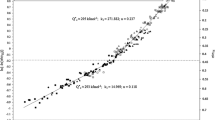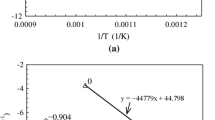Abstract
A new parametric approach, termed the Wilshire equations, offers the realistic potential of being able to accurately lift materials operating at in-service conditions from accelerated test results lasting no more than 5000 hours. The success of this approach can be attributed to a well-defined linear relationship that appears to exist between various creep properties and a log transformation of the normalized stress. However, these linear trends are subject to discontinuities, the number of which appears to differ from material to material. These discontinuities have until now been (1) treated as abrupt in nature and (2) identified by eye from an inspection of simple graphical plots of the data. This article puts forward a statistical test for determining the correct number of discontinuities present within a creep data set and a method for allowing these discontinuities to occur more gradually, so that the methodology is more in line with the accepted view as to how creep mechanisms evolve with changing test conditions. These two developments are fully illustrated using creep data sets on two steel alloys. When these new procedures are applied to these steel alloys, not only do they produce more accurate and realistic looking long-term predictions of the minimum creep rate, but they also lead to different conclusions about the mechanisms determining the rates of creep from those originally put forward by Wilshire.






Similar content being viewed by others
References
ASME Boiler & Pressure Vessel Code, Sec. II, Part D, Appendix I, ASME, 2004.
2. D. Allen and S. Garwood: Materials Energy Review, IoMMH, London, 2007.
3. B. Wilshire and A.J. Battenbough: Mater. Sci. Eng. A, 2007, vol. 443, pp. 156–66.
4. B. Wilshire and P.J. Scharning: Mater. Sci. Technol., 2008, vol. 24 (1), pp. 1–9.
5. B. Wilshire and M. Whittaker: Mater. Sci. Technol., 2011, vol. 27 (3), pp. 642–47.
6. B. Wilshire and P.J. Scharning: Int. Mater. Rev., 2008, vol. 53 (2), pp. 91–104.
7. A. Abdallah, K. Perkins, and S. Williams: Mater. Sci. Eng. A, 2012, vol. 550, pp. 176–82.
8. M.T. Whittaker, M. Evans, and B. Wilshire: Mater. Sci. and Eng. A, 2012, vol. 552, pp. 145–50.
National Institute for Materials Science, Creep Data Sheet No. 9b: Data sheets on the elevated-temperature properties of 1Cr-1Mo-0.25 steel forgings for rotors and shafts, 1990.
National Institute for Materials Science, Creep Data Sheet No. M-6: Metallographic atlas of long term crept materials, 2007.
National Institute for Materials Science, Creep Data Sheet No. 3b: Data sheets on the elevated-temperature properties of 2.25Cr-1Mo steel, 1986.
12. H. Tong: Threshold Models in Non-Linear Time Series Analysis, vol. 21, Lecture Notes in Statistics, Springer-Verlag, New York, NY, 1983.
V. Martin, S. Hurn, and D. Harris: Econometric Modelling with Time Series: Specification, Estimation and Testing, Cambridge University Press, Cambridge, United Kingdom, 2013, ch. 19
14. M. Evans: Metall. Mater. Trans. A, 2015, vol. 46 (2), pp. 937–47.
G. Vinning and S.M. Kowalski: Statistical Methods for Engineers, 3rd ed., Brooks/Cole, Boston, MA, 2011, ch. 6
16. R. Luukkonen, P. Saikkonen, and T. Terasvirta: Biometrica, 1988, vol. 75, pp. 491–99.
17. B.E. Hansen: Econometrica, 1996, vol. 50, pp. 1269–86.
18. T.H. Lee, H. White, and C.W.J. Granger: J. Economet., 1993, vol. 5 (6), pp. 269–90.
Author information
Authors and Affiliations
Corresponding author
Additional information
Manuscript submitted November 3, 2015.
Rights and permissions
About this article
Cite this article
Evans, M. A Statistical Test for Identifying the Number of Creep Regimes When Using the Wilshire Equations for Creep Property Predictions. Metall Mater Trans A 47, 6593–6607 (2016). https://doi.org/10.1007/s11661-016-3750-x
Received:
Published:
Issue Date:
DOI: https://doi.org/10.1007/s11661-016-3750-x




